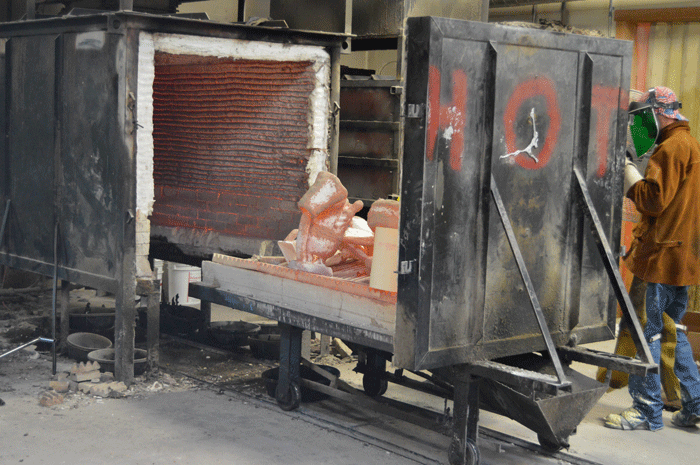Initially I assumed that I would get the casting done in Colorado and return home with the Waterbearer in many pieces. My welder friend in Lynchburg is excellent, quite possibly the best I've ever known. At some point during my first weeks in Colorado I became convinced that I could find someone there to do at least the initial welding of the base to make the future mountings "industry standard" and began my quest to find someone available that could work fast. My search led me around in circles for a while until I ended up back where I had started, back at Madd. I was out in the parking lot admiring an old '66 Chevy Nova one day when a gentlemen approached me and we began talking about his car. His name was Bryan and he was ambitious enough to get the job.
Transporting the cast bronze to his shop was as easy as forklifting it across the parking lot and through an open bay door, he was that close. Once he got started I gave him three days to have it rough welded. By the end of the first day I began to push harder and urged him in my kindest manner to take it through as far as he could. I had to have the van back in Lynchburg by the coming Sunday and the clock was ticking.
 |
| And so it begins. |
 |
| Adjusting her posture and "attitude" took a lot of guidance. |
 |
| "Stay out of the light! Don't look at the light!" Well, so long retinas. |
 |
| Closer and closer. |
 |
| Almost there. Faster, Bryan! Faster!! |
 |
| The moment of truth! I'm a very proud papa. |
 |
| Back in the van and ready to make the long drive home. |
In the end, he was still defect welding when we brought the dolly around and started pushing her towards the open van. A lot of manly grunting later and she was in the back and secured for the drive ahead.
All in all, I was in Colorado for nearly seven weeks (including travel time). I saw many amazing sights, re-connected with a lot of old and dear friends and even made a few new ones (hey, Vanessa!). I've always considered it my second home and while I don't miss the winters in the slightest, I do miss the artistic camaraderie and sense of belonging to a community of like-minded misfits.
The journey home was thankfully uneventful. I left CO on Thursday afternoon and was back home in VA by Saturday evening, exhausted but elated that it all went so smoothly. Time to relax for a few hours. I think my cat missed me.
Now that we're all completely caught up here, what's next? Next week I begin the long, physical process of metal chasing the Waterbearer. It will be tiring. It will be sticky. It will be itchy. Mostly it will be rewarding. I'm starting to think I was made for this stuff.
Stay tuned!










































